The clock is ticking and it does not seem like the Central Tibetan Administration (CTA) has a lot of time left or much administration work to perform in the very near future. This article could not have surfaced at a better time, bringing attention to a few very crucial yet sensitive points surrounding the inevitable – that the Tibetans have to face the reality of “what will happen after the Dalai Lama enters clear light?”
The future undoubtedly looks uncertain for the entire Tibetan diaspora community in India, as the number of refugees coming into India has drastically dropped. Here are some of painfully obvious facts brought forth in article, which I would like to highlight.
There was only one student in the classroom. “There were 12 or 13 students several years ago,” said the lonely-looking man in his 20s studying computer graphics in the corner.
The classroom is at a boarding school in Dharamsala, in northern India, where the Central Tibetan Administration, better known as the Tibetan government-in-exile, is located. People ages 18 to 30 who have recently fled the Tibet Autonomous Region in China receive basic education and job training here for three to eight years. The school had 700 students nine years ago, but the number has since dropped to 101. The third floor of the three-story building is vacant, many of its windows left broken.
Silence also reigns in the refugee reception center, the first stop for Tibetan exiles arriving in Dharamsala and seeking registration as refugees. The facility can accommodate 1,000 people, but recently only staff are present on many days. “Before 2008, over 3,500 refugees came here annually,” said Wangchuk, 45, a researcher at the center. “Now [the figure] hardly crosses 100.” It is especially rare to see children and women nowadays, according to Wangchuk.
The above three points informs us that the influx of Tibetan refugees coming in to India has dramatically dropped to less than 100. This does not sound good as it shows there will be less and less Tibetans in India, leading to the halt of growth of what is left of its small community. So who will the CTA lead if there is no one to lead? Will the CTA become redundant then?
But according to one monk in his 30s, “Everyone always feels anxiety about one thing,” namely, what will happen after the 14th Dalai Lama, who turned 81 in July, dies.
But people are worried. “We always fear whether we’ll be able to stay here [in India] after His Holiness passes away,” said a 20-year-old saleswoman at a mobile phone shop.
This is the inevitable and painful truth, but there is no doubt that it’s on the mind of every exiled Tibetan. It seems that the exiled Tibetans’ only hope and security is the Dalai Lama. It doesn’t say much about the CTA’s leadership qualities. Sadly, it does not look like Tibetans have a lot of confidence in their own administrative leaders guiding them. Those who have the resources would have probably prepared themselves to leave and migrate to another country as soon as the Dalai Lama passes. In fact, it has already begun as we witness many Tibetans migrating to other parts of the world such as the United States and Europe.
Sangay assumed political leadership of the exiled Tibetans in 2011. The Dalai Lama, who received the Nobel Peace Prize in 1989, has influence with the leaders of many countries and is a spiritual pillar for Tibetans. “It is very difficult, almost impossible, to replace the charisma, the stature, the profile of His Holiness the Dalai Lama,” Sangay said. “No Tibetans can.”
Yes, Lobsang Sangay is probably correct in the statement above, that no one, not even the CTA could ever replace the Dalai Lama, what he is capable of doing and what he has accomplished. This is exactly why having the CTA around after the Dalai Lama’s passing would probably be redundant. In other words, this event will also mean the end of the road for the CTA as well.
Still, he expressed confidence that there will be a 15th Dalai Lama, suggesting three ways one could be chosen: through “reincarnation,” selection by all the high lamas or designation by the current Dalai Lama. At the same time, Sangay promised that the government would take responsibility for carrying on the “Tibetan freedom struggle.”
Sangay said he will maintain the policy of direct dialogue with Beijing that the 14th Dalai Lama has pursued. To do so, the foothold of the government-in-exile in Dharamsala is essential.
The prime minister conceded that “independence is not possible for Tibetans,” but he stressed that China’s own laws make genuine autonomy a possibility. “Environmental protection, religious and cultural preservation, economic benefits for Tibetan ‘minorities’ — all this is there in Chinese law.”
There are hints that such worries may be justified. According to one highly placed source in the Rashtriya Swayamsevak Sangh (National Volunteer Organization, or RSS), a Hindu nationalist group from which Indian Prime Minister Narendra Modi draws support, a deal was discussed in informal talks during Chinese President Xi Jinping’s visit to India in 2014 and a reciprocal visit by Modi to China last year.
Under the arrangement discussed, the source said, “China would not officially lay claim to several Indian territories, such as Sikkim, Arunachal Pradesh and parts of Jammu and Kashmir state.” In exchange, “after the death of the current Dalai Lama, the Indian government would offer Tibetan exiles living in India citizenship — and literally stop new exiles coming through Nepal to India. The Tibetan government-in-exile would also have to go.”
The smart and most obvious thing to do is for Lobsang Sangay to take whatever opportunity he has left right now to create good ties with China. If Sangay hopes for direct dialogue with Beijing, it would be wise for him to stop slandering China for a start. Next would be to cease all direct and indirect propaganda against China, to advise many of their Free Tibet followers to also stop slighting China and jeopardising their every chance for dialogue or any kind of agreement. Only then, could there be a glimpse of hope for genuine autonomy, otherwise it seems like the CTA would have to pack up and draw the curtains. What will happen to the Tibetans in exile then? Hence this would also mean that whatever the CTA is doing against Dorje Shugden and imposing a ban on Dorje Shugden will become obsolete. What ban is there to enforce if there is no CTA? This is, in a way, good news for us Shugden practitioners, for all those who have been wronged by the CTA and the general population of Tibetan exile community as well.
Tibet’s Exiles in India Confront an Uncertain Future
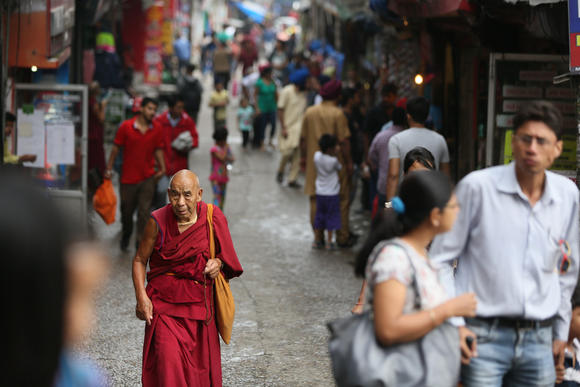
McLeod Ganj, part of the Indian city of Dharamsala, is home to a large population of Tibetans. (Photo by Keiichiro Asahara)
DHARAMSALA, India — There was only one student in the classroom. “There were 12 or 13 students several years ago,” said the lonely-looking man in his 20s studying computer graphics in the corner.
The classroom is at a boarding school in Dharamsala, in northern India, where the Central Tibetan Administration, better known as the Tibetan government-in-exile, is located. People ages 18 to 30 who have recently fled the Tibet Autonomous Region in China receive basic education and job training here for three to eight years. The school had 700 students nine years ago, but the number has since dropped to 101. The third floor of the three-story building is vacant, many of its windows left broken.
Silence also reigns in the refugee reception center, the first stop for Tibetan exiles arriving in Dharamsala and seeking registration as refugees. The facility can accommodate 1,000 people, but recently only staff are present on many days. “Before 2008, over 3,500 refugees came here annually,” said Wangchuk, 45, a researcher at the center. “Now [the figure] hardly crosses 100.” It is especially rare to see children and women nowadays, according to Wangchuk.
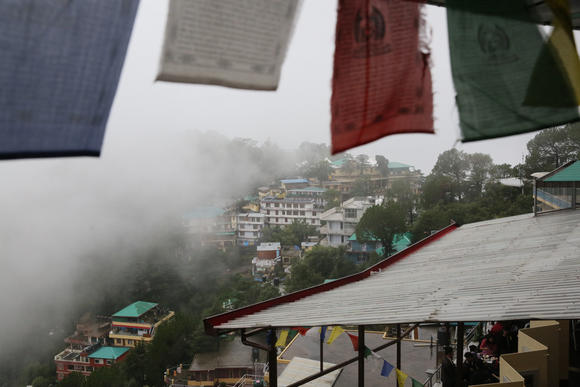
Dalai Lama temple seen at the hilltop of Dharamsala, northern India.
The reason for the sharp drop-off in asylum seekers is that leaving China has become much more difficult.
Fleeing Tibet has always been hard. Most refugees carry the food they need for the journey on their backs and head for India via the Nepalese capital, Kathmandu. Nepal borders China and recognizes Tibetans as refugees. However, even if they manage to slip past China’s guards on the frontier, they face crossing the Himalayas on foot. They are at risk of death or injury from frostbite and falls.
Moreover, border security has been tightened since 2008, when the Beijing Olympics took place. That year, “riots” or “peaceful protests” — depending on whether one is speaking to Chinese officials or Tibetan refugees — occurred around the Tibet Autonomous Region. That led to heavier surveillance, not only in cities but in villages and near the border. Around that time, “China started to give equipment to Nepalese police and train them in Tibet,” said a person with connections to the Tibetan government-in-exile. Beijing encouraged the police to arrest and forcibly repatriate refugees who had fled across the border.
The results were dramatic. According to refugees, guided journeys used to take 20 to 30 days from the Tibetan capital of Lhasa to Kathmandu. But, said one person who fled several years ago, “I didn’t have a guide and lost my way, so it took me a month and 20 days.”
As the number of new arrivals has dwindled, more Tibetans have committed self-immolation in Tibet and elsewhere in protest of Chinese policy. More than 140 people have burned themselves to death since 2009. “Father, being a Tibetan is so difficult,” one 23-year-old mother wrote in her suicide note. “We can’t even display the Dalai Lama’s portrait. We have no freedom at all.” At the Tibet Museum in Dharamsala, such suicide notes are exhibited, along with the photographs of about 100 people who have immolated themselves.
Looking back — and forward
According to “Tibetan Nation,” by U.S. historian Warren W. Smith, seventh-century Tibet was a unified, independent state that rivaled China’s Tang dynasty for influence in Inner Asia. After the 13th century, Tibet built a priest-patron relationship with the Mongols, in which Tibet relied on them for military power while the Mongols were subject to Tibet in religious matters under the Dalai Lama, the supreme leader of Tibetan Buddhism.
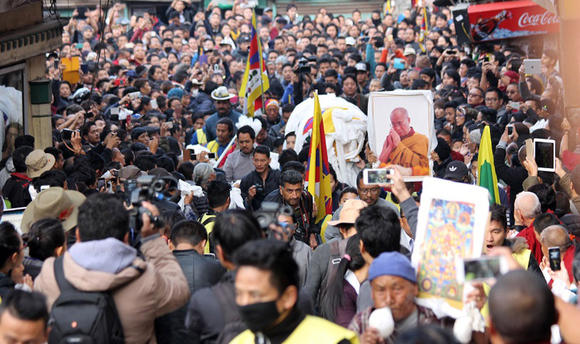
The body of 16-year-old Tibetan student and exile Dorjee Tsering, who died after immolating himself to protest Chinese rule in Tibet, is carried through Dharamsala, India, on March 5.
Based on diplomatic documents and other historical records, Smith argues Tibet managed to achieve de facto independence under British patronage in the early 20th century. However, China, which claimed that Tibet was part of its territory, moved troops into the area around 1950, and the 14th Dalai Lama took refuge in India in 1959.
So far, about 130,000 Tibetans fled to India, including Dharamsala, New Delhi and the southern state of Karnataka. The 10,000 or so Tibetans of Dharamsala — members of the government-in-exile, Buddhist monks and ordinary workers — say they are grateful to India for giving them a place to live and freedom. But according to one monk in his 30s, “Everyone always feels anxiety about one thing,” namely, what will happen after the 14th Dalai Lama, who turned 81 in July, dies.
The Dalai Lama “is very healthy,” Lobsang Sangay, prime minister of the government-in-exile, said in an interview with the Nikkei Asian Review. “He will live for the next five years, I am sure.”
Sangay assumed political leadership of the exiled Tibetans in 2011. The Dalai Lama, who received the Nobel Peace Prize in 1989, has influence with the leaders of many countries and is a spiritual pillar for Tibetans. “It is very difficult, almost impossible, to replace the charisma, the stature, the profile of His Holiness the Dalai Lama,” Sangay said. “No Tibetans can.”
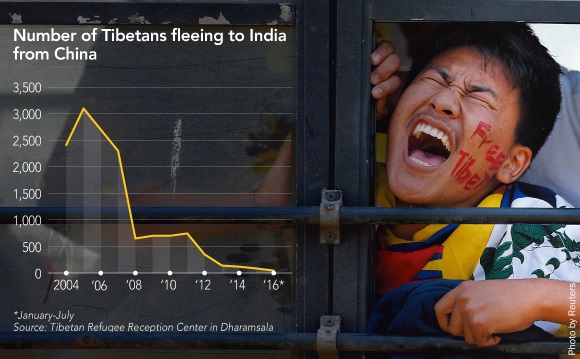
Still, he expressed confidence that there will be a 15th Dalai Lama, suggesting three ways one could be chosen: through “reincarnation,” selection by all the high lamas or designation by the current Dalai Lama. At the same time, Sangay promised that the government would take responsibility for carrying on the “Tibetan freedom struggle.”
But people are worried. “We always fear whether we’ll be able to stay here [in India] after His Holiness passes away,” said a 20-year-old saleswoman at a mobile phone shop.
There are hints that such worries may be justified. According to one highly placed source in the Rashtriya Swayamsevak Sangh (National Volunteer Organization, or RSS), a Hindu nationalist group from which Indian Prime Minister Narendra Modi draws support, a deal was discussed in informal talks during Chinese President Xi Jinping’s visit to India in 2014 and a reciprocal visit by Modi to China last year.
Under the arrangement discussed, the source said, “China would not officially lay claim to several Indian territories, such as Sikkim, Arunachal Pradesh and parts of Jammu and Kashmir state.” In exchange, “after the death of the current Dalai Lama, the Indian government would offer Tibetan exiles living in India citizenship — and literally stop new exiles coming through Nepal to India. The Tibetan government-in-exile would also have to go.”
The agenda will be “advanced gradually,” the RSS official said, because the two leaders do not want to be seen as weak by their own citizens for having compromised.
Sangay has his doubts, since such an agreement would be based on a “false premise.” “The Chinese government has designs not simply on Tibet but the whole world,” he said. “That includes the South China Sea, East China Sea, ASEAN, Africa, Latin America, everywhere. Giving Tibet as a concession will not satisfy China at all.”
The prime minister conceded that “independence is not possible for Tibetans,” but he stressed that China’s own laws make genuine autonomy a possibility. “Environmental protection, religious and cultural preservation, economic benefits for Tibetan ‘minorities’ — all this is there in Chinese law.”
Sangay said he will maintain the policy of direct dialogue with Beijing that the 14th Dalai Lama has pursued. To do so, the foothold of the government-in-exile in Dharamsala is essential. In his book, Smith quotes a 1912 British diplomatic document saying Tibet “should in reality be placed in a position of absolute dependence on the Indian government.” After more than 100 years, that has not changed.
“Now, in India, we have the strong leadership of Prime Minister Modi. It is a good opportunity to help the Tibetan people,” said Manav Jain, 20, an Indian student who visited the Tibet Museum and was grieved by the photos of people who had burned themselves to death. The question is whether Modi, who hopes to remain in office until 2024, will respond positively to the gratitude of Tibetans and the expectations of young people of his own country.
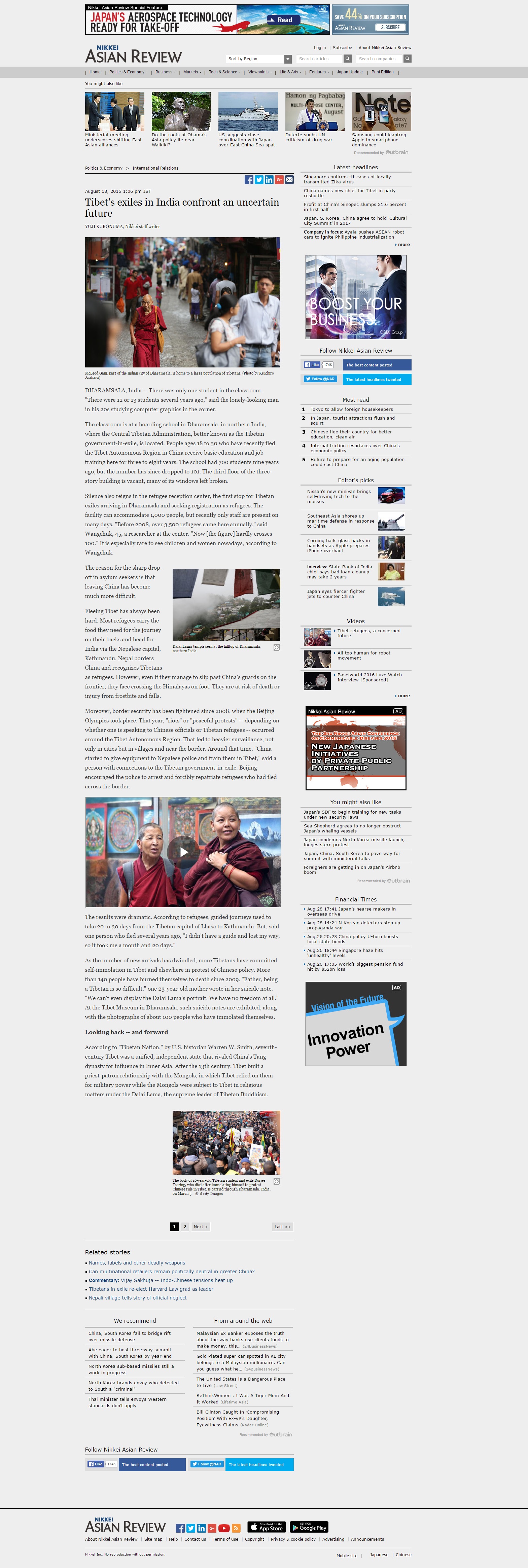
Click on image to enlarge.

Click on image to enlarge
Interesting Development
Two days after the world learnt that India has most likely signed away the Tibetan people’s future, the Tibetan leadership held a press conference in Dharamsala to do damage control caused by the startling revelation as reported by Nikkei Asian Review on August 18, 2016. Known to be an internationally renowned media outlet and respected for their integrity in reporting, it would be illogical to assume that Nikkei would risk their reputation to report false news, especially on something so sensitive and significant, without having good proof and reliable sources. In fact, Nikkei is a much more reputable publication than any outlet the Tibetan leadership releases their news through, and the Nikkei has a much larger distribution, audience and reach too.
Following the press conference, media controlled by the Tibetan leadership reported the event. However, they failed to mention the original meetings that took place between the Indian and Chinese governments regarding the Tibetan issue. In fact it seems that they intentionally omitted this fact when reporting, where as other more reputable sources such as Nikkei clearly mentioned it. The appearance of the press conference’s venue did not create an atmosphere of august and distinguished governance to the hastily-thrown together press conference needed to cover their embarrassment. The Coke machine dispenser in the back probably drew more attention than the speakers.
In keeping with Indian political tendency to beat around the bush, those who hosted the press conference did not actually state if the news about Tibet’s future was true or not. Rather, they circumvented the real topic – that people have been discussing Tibet’s future, without the involvement and input of the Tibetan so-called leadership. This is a clear sign that the Central Tibetan Administration (CTA) is not in control of the situation and their own future but are left to the whims of the Indian government, and used as pawns to assert the sovereignty of India towards the Chinese. While the Tibetan leadership most probably thought to downplay the initial news by hosting a press conference and failing to mention the India-China meeting in the subsequent reporting, their tactic backfired highlighting their incompetency, impotent leadership and lack of control over their own future.
It must have been somewhat humiliating to have such a reputable media outlet highlight the fact that upon the passing of His Holiness the Dalai Lama, the CTA will most obviously be abolished by the Indian government. Tibetan offices will be shut down, Tibetans will be made to take up Indian citizenship and the Tibetan Administration will ultimately cease to exist. Furthermore no more Tibetan refugees will be allowed into India. Everything the CTA have been supposedly working to preserve for the last 60 years will suddenly disappear overnight, with nothing left to show for their efforts. In fact, if you visit Dharamsala today, you can see many of the Tibetan denizens are leaving, moving to foreign countries or planning to move abroad. In the end, sadly, what seems to be Tibet’s real future will be nothing more than a desolate Dharamsala and an isolated Tibetan ‘leadership’, with most of the Tibetans living abroad and slowly losing their culture.
The CTA’s version of events
Note that this report posted on the official Central Tibetan Administration website does NOT mention the meeting between India and China, which certainly took place and was the main reason they held this press conference to begin with.
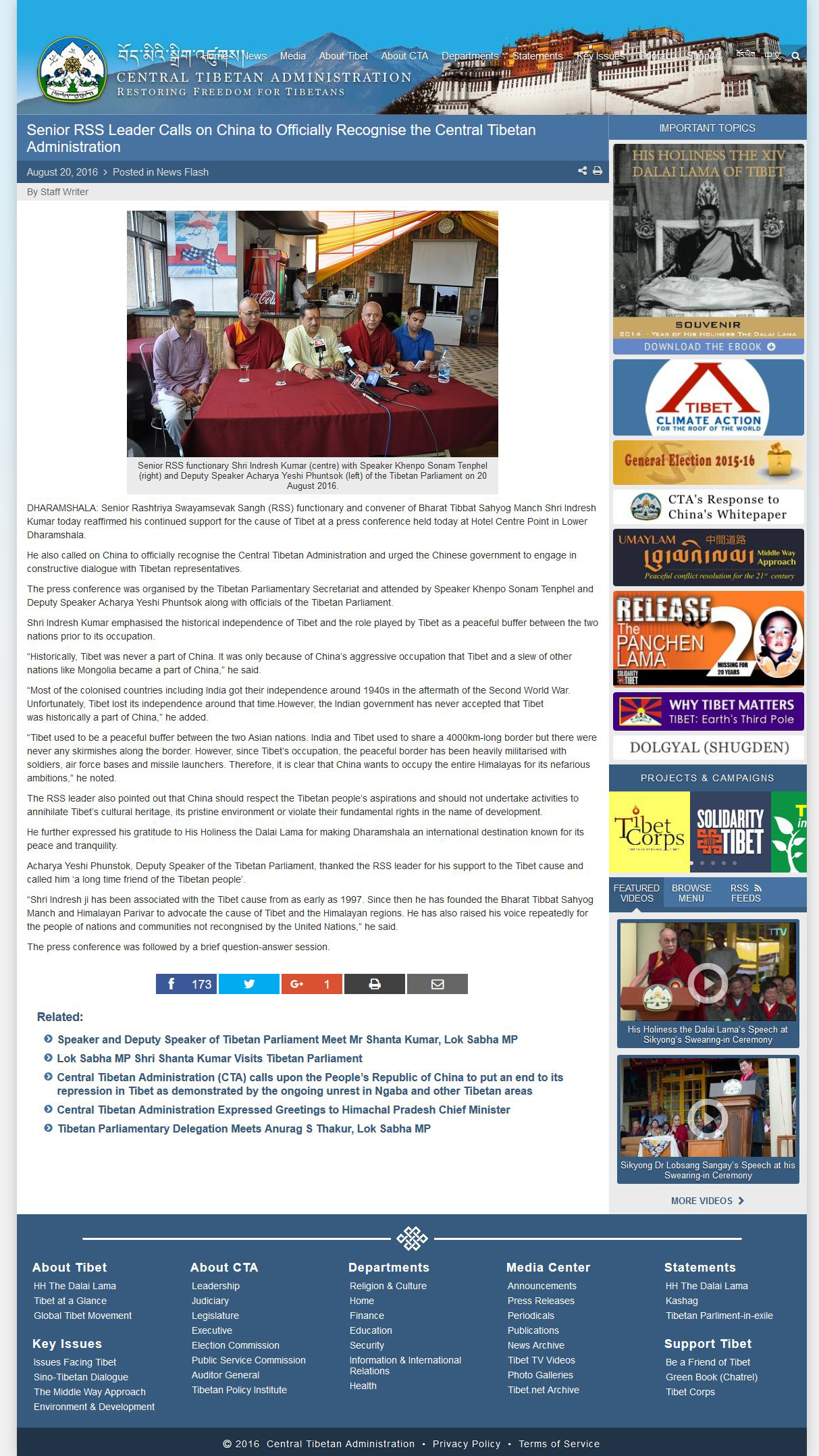
The rest of the world’s version of events
Note that this report, along with many others, posted on other media outlets, all clearly state and confirm that a meeting took place between between India and China. What is the CTA trying to hide by refusing to publish the entire news story on their website?
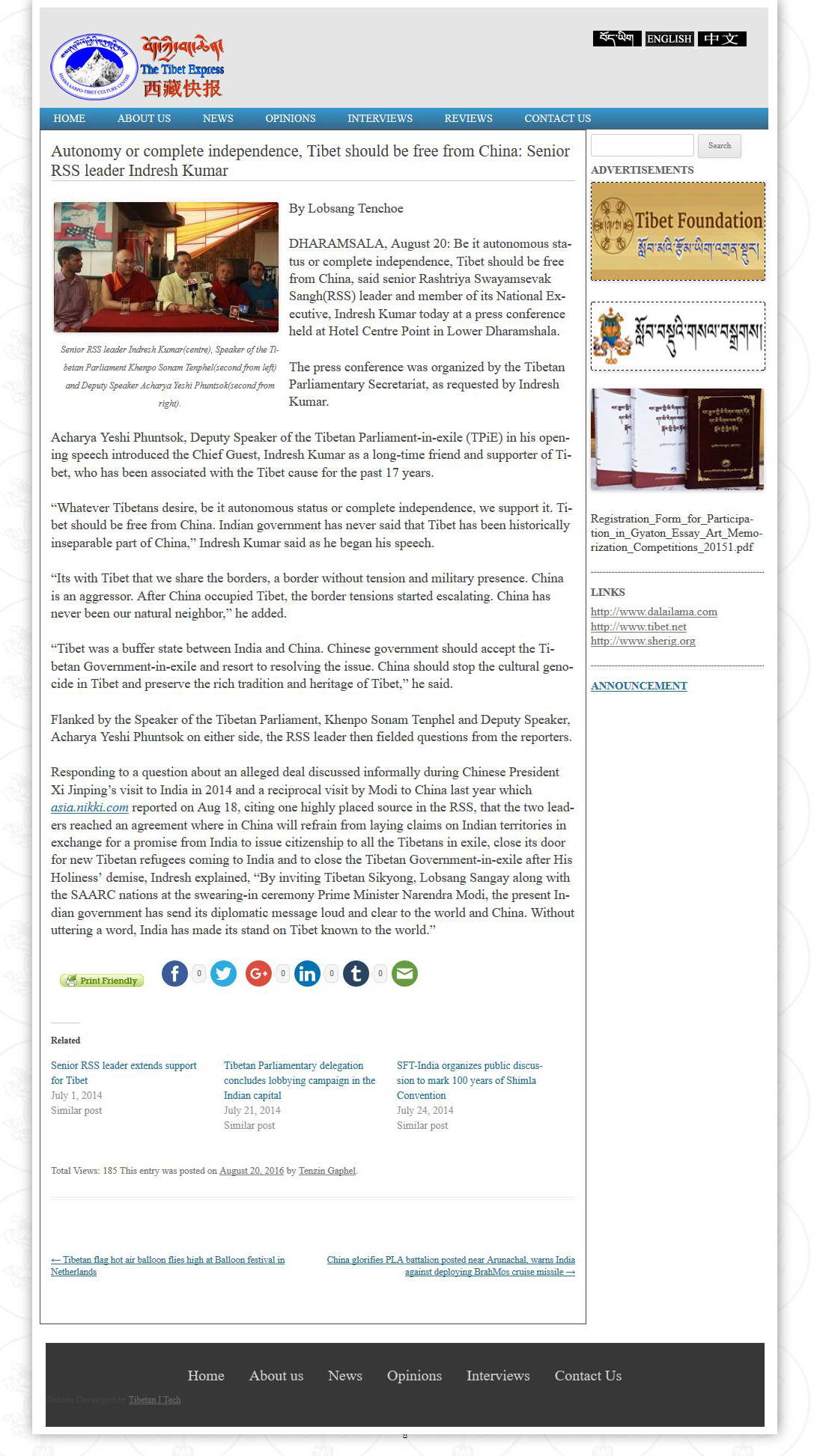
MORE NEWS LIKE THIS